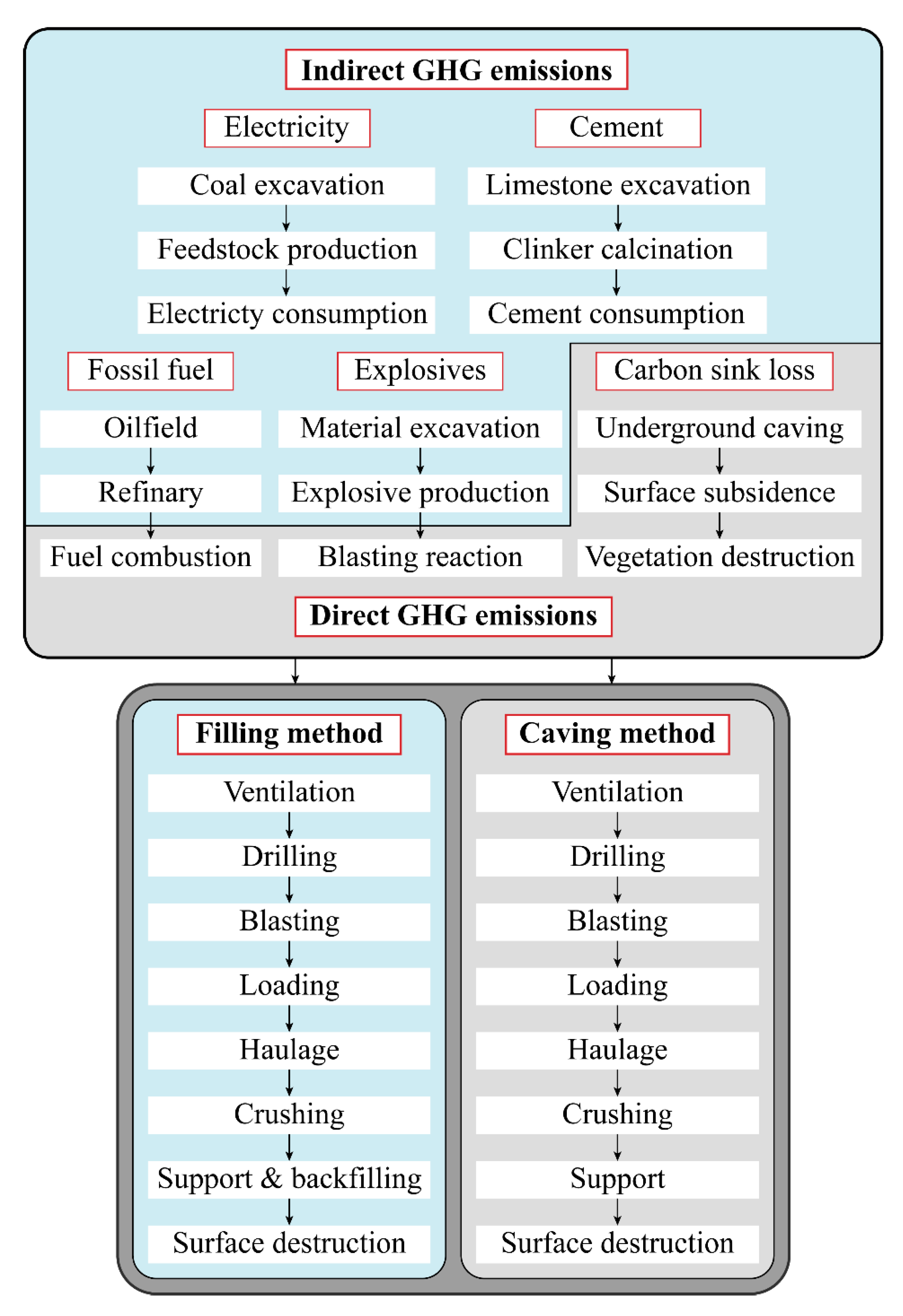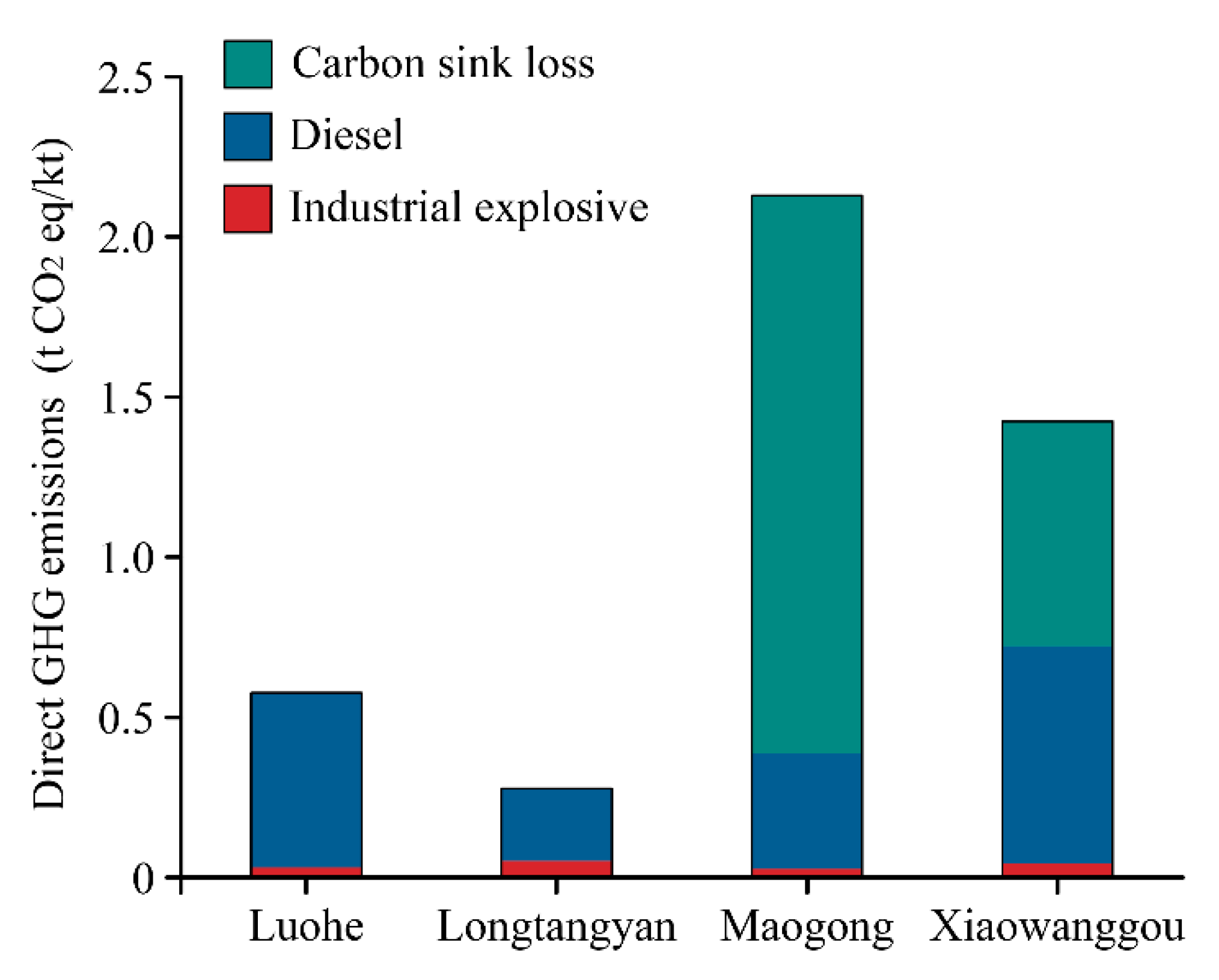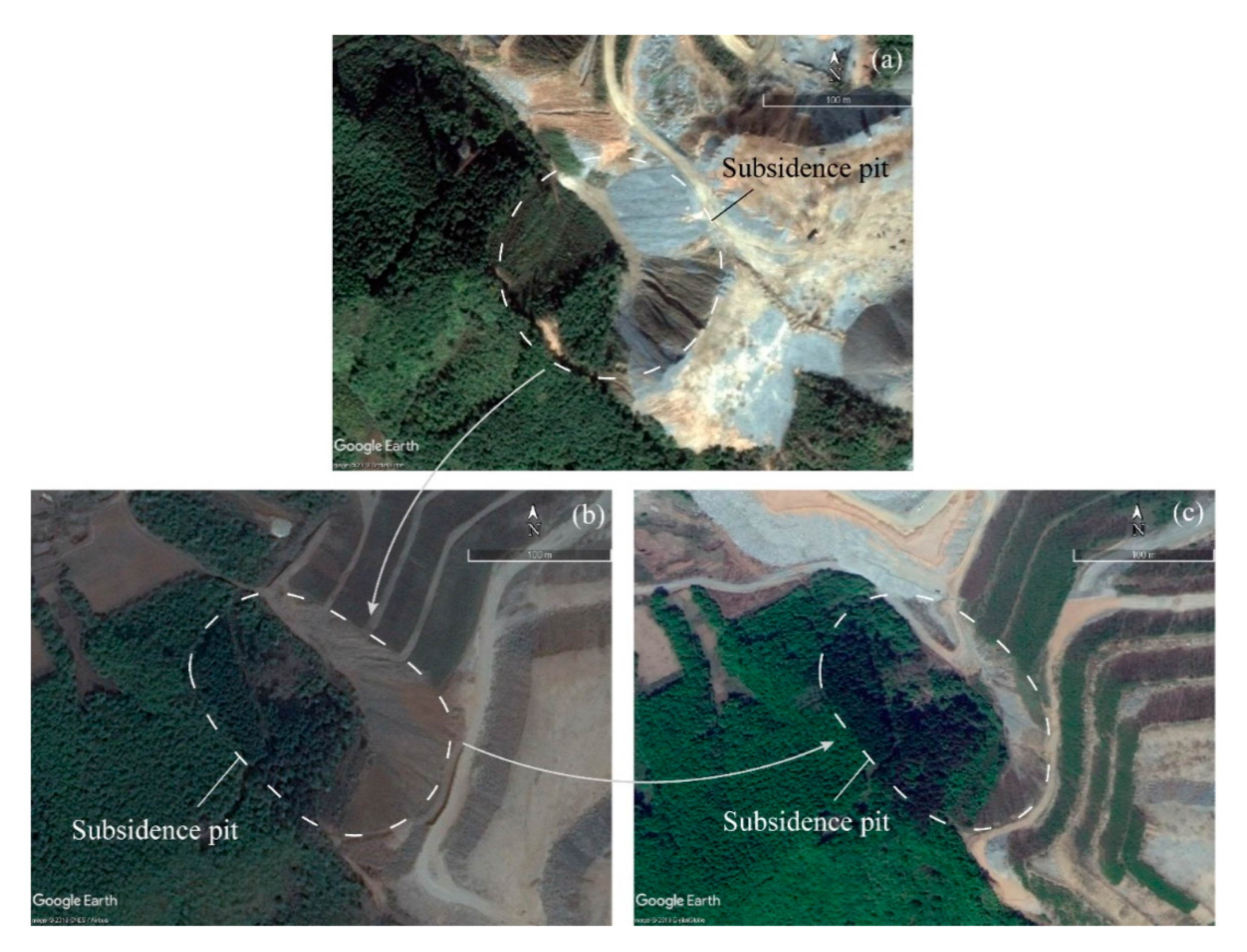Climate Impact of China’s Promotion of the Filling Mining Method: Bottom-Up Estimation of Greenhouse Gas Emissions in Underground Metal Mines
Abstract
:1. Introduction
2. Materials and Methods
2.1. System Boundary Definition
2.2. Emission Factors of GHG Emission Sources
2.2.1. Fossil Fuel
2.2.2. Electricity
2.2.3. Industrial Explosives
2.2.4. Cement
2.2.5. Carbon Sink Loss
2.3. Bottom-Up Model for GHG Emissions
2.3.1. Ventilation
2.3.2. Drilling
2.3.3. Blasting
2.3.4. Loading
2.3.5. Haulage
2.3.6. Crushing
2.3.7. Support and Backfilling
2.3.8. Surface Destruction
3. Case Study
3.1. Inputs
3.2. Results
3.3. Discussion and Implications
4. Conclusions
Author Contributions
Funding
Institutional Review Board Statement
Informed Consent Statement
Data Availability Statement
Acknowledgments
Conflicts of Interest
References
- Guan, D.; Peters, G.P.; Weber, C.L.; Hubacek, K. Journey to world top emitter: An analysis of the driving forces of China’s recent CO2 emissions surge. Geophys. Res. Lett. 2009, 36, 1–5. [Google Scholar] [CrossRef] [Green Version]
- Yin, J.N.; Huang, G.H.; Xie, Y.L.; An, Y.K. Carbon-subsidized inter-regional electric power system planning under cost-risk tradeoff and uncertainty: A case study of Inner Mongolia, China. Renew. Sustain. Energy Rev. 2021, 135, 110439. [Google Scholar] [CrossRef]
- Wang, J.; Zhong, H.; Yang, Z.; Wang, M.; Kammen, D.M.; Liu, Z.; Ma, Z.; Xia, Q.; Kang, C. Exploring the trade-offs between electric heating policy and carbon mitigation in China. Nat. Commun. 2020, 11, 1–11. [Google Scholar] [CrossRef]
- Zhou, J.; Huo, X.; Jin, B.; Yu, X. The efficiency of carbon trading market in China: Evidence from variance ratio tests. Environ. Sci. Pollut. Res. 2019, 26, 14362–14372. [Google Scholar] [CrossRef]
- Ministry of Natural Resources. Notification of the Index of the Evaluation Systems for Green Mines and the Requirements for the Evaluation and Promotion of Green Mine by Third Party. 2020. Available online: http://gi.mnr.gov.cn/202006/t20200601_2521979.html (accessed on 1 June 2020).
- Yin, S.; Shao, Y.; Wu, A.; Wang, H.; Liu, X.; Wang, Y. A systematic review of paste technology in metal mines for cleaner production in China. J. Clean. Prod. 2020, 247, 119590. [Google Scholar] [CrossRef]
- Liu, Y.; Liu, Z.; Li, K.; Deng, S.; Dong, L. A cleaner mining method for waste tailings as paste materials to goafs. Geofluids 2020, 2020, 8857290. [Google Scholar] [CrossRef]
- Parmar, H.; Yarahmadi Bafghi, A.; Najafi, M. Impact of ground surface subsidence due to underground mining on surface infrastructure: The case of the Anomaly No. 12 Sechahun, Iran. Environ. Earth Sci. 2019, 78, 1–14. [Google Scholar] [CrossRef]
- Li, W.X.; Wen, L.; Liu, X.M. Ground movements caused by deep underground mining in Guan-Zhuang iron mine, Luzhong, China. Int. J. Appl. Earth Obs. Geoinf. 2010, 12, 175–182. [Google Scholar] [CrossRef]
- Deng, Y.; Chen, C.; Xia, K.; Yang, K.; Sun, C.; Zheng, X. Investigation on the characteristics of overlying strata caving in the Chengchao Iron Mine, China. Environ. Earth Sci. 2018, 77, 362. [Google Scholar] [CrossRef]
- National Bureau of Statistic. The Profits of Industrial Enterprises above Designated Size Fell by 3.3 Percent in 2019. 2020. Available online: http://www.stats.gov.cn/tjsj/zxfb/202002/t20200203_1724853.html (accessed on 3 February 2020).
- Liu, Y.; Ren, F.; Ding, H. Impact analysis of carbon prices on metal mining projects by block-based estimation model: Implications for cleaner production. J. Clean. Prod. 2019, 229, 695–705. [Google Scholar] [CrossRef]
- Zhang, Z.C.; Fei, R.L. Illuminating the efficiency of CO2 emissions in China’s mining sector: Evidence from meta-frontier Malmquist index models. Environ. Sci. Pollut. Res. 2020, 28, 1823–1836. [Google Scholar] [CrossRef]
- Wang, M.; Feng, C. Decoupling economic growth from carbon dioxide emissions in China’s metal industrial sectors: A technological and efficiency perspective. Sci. Total Environ. 2019, 691, 1173–1181. [Google Scholar] [CrossRef]
- Gan, Y.; Griffin, W.M. Analysis of life-cycle GHG emissions for iron ore mining and processing in China-Uncertainty and trends. Resour. Policy 2018, 58, 90–96. [Google Scholar] [CrossRef]
- Nilsson, A.E.; Aragones, M.M.; Torralvo, F.A.; Dunon, V.; Angel, H.; Komnitsas, K.; Willquist, K. A review of the carbon footprint of Cu and Zn production from primary and secondary sources. Minerals 2017, 7, 168. [Google Scholar] [CrossRef] [Green Version]
- Shao, S.; Liu, J.; Geng, Y.; Miao, Z.; Yang, Y. Uncovering driving factors of carbon emissions from China’s mining sector. Appl. Energy 2016, 166, 220–238. [Google Scholar] [CrossRef]
- Farjana, S.H.; Huda, N.; Mahmud, M.A.P. Impacts of aluminum production: A cradle to gate investigation using life-cycle assessment. Sci. Total Environ. 2019, 663, 958–970. [Google Scholar] [CrossRef]
- Xia, K.; Chen, C.; Deng, Y.; Xiao, G.; Zheng, Y.; Liu, X.; Fu, H.; Song, X.; Chen, L. In situ monitoring and analysis of the mining-induced deep ground movement in a metal mine. Int. J. Rock Mech. Min. Sci. 2018, 109, 32–51. [Google Scholar] [CrossRef]
- Justs, J.; Wyrzykowski, M.; Winnefeld, F.; Bajare, D.; Lura, P. Influence of superabsorbent polymers on hydration of cement pastes with low water-to-binder ratio: A calorimetry study. J. Therm. Anal. Calorim. 2014, 115, 425–432. [Google Scholar] [CrossRef]
- Yilmaz, E.; Belem, T.; Bussière, B.; Mbonimpa, M.; Benzaazoua, M. Curing time effect on consolidation behaviour of cemented paste backfill containing different cement types and contents. Constr. Build. Mater. 2015, 75, 99–111. [Google Scholar] [CrossRef]
- Liu, Z.; Guan, D.; Wei, W.; Davis, S.J.; Ciais, P.; Bai, J.; Peng, S.; Zhang, Q.; Hubacek, K.; Marland, G.; et al. Reduced carbon emission estimates from fossil fuel combustion and cement production in China. Nature 2015, 524, 335–338. [Google Scholar] [CrossRef] [Green Version]
- Costa, F.N.; Ribeiro, D.V. Reduction in CO2 emissions during production of cement, with partial replacement of traditional raw materials by civil construction waste (CCW). J. Clean. Prod. 2020, 276, 123302. [Google Scholar] [CrossRef]
- International Organization for Standardization. Environmental Management—Life Cycle Assessment: Principles and Framework (ISO 14040); International Organization for Standardization: Geneva, Switzerland, 2006. [Google Scholar]
- Intergovernmental Panel on Climate Change. 2006 IPCC Guidelines for National Greenhouse Gas Inventories; Intergovernmental Panel on Climate Change: Kanagawa, Japan, 2006; Chapter 3 Mobile Combustion; Volume 2. [Google Scholar]
- Argonne National Laboratory. The Greenhouse Gases, Regulated Emissions, and Energy Use in Transportation Model, GREET 1.8d.1; Argonne National Laboratory: Argonne, IL, USA, 2010. Available online: http://greet.es.anl.gov (accessed on 14 December 2010).
- Stocker, T.F.; Qin, D.H.; Plattner, G.K.; Alexander, L.V.; Allen, S.K.; Bindoff, N.L.; Breon, F.M.; Church, J.A.; Cubasch, U.; Emori, S.; et al. Technical Summary in Climate Change 2013: The Physical Science Basis; Cambridge University Press: Cambridge, UK; New York, NY, USA, 2013. [Google Scholar] [CrossRef]
- Masnadi, M.S.; El-Houjeiri, H.M.; Schunack, D.; Li, Y.; Roberts, S.O.; Przesmitzki, S.; Brandt, A.R.; Wang, M. Well-to-refinery emissions and net-energy analysis of China’s crude-oil supply. Nat. Energy 2018, 3, 220–226. [Google Scholar] [CrossRef]
- Abdul-Manan, A.F.N.; Arfaj, A.; Babiker, H. Oil refining in a CO2 constrained world: Effects of carbon pricing on refineries globally. Energy 2017, 121, 264–275. [Google Scholar] [CrossRef]
- Ozgen, S.; Caserini, S. Methane emissions from small residential wood combustion appliances: Experimental emission factors and warming potential. Atmos. Environ. 2018, 189, 164–173. [Google Scholar] [CrossRef]
- Huang, Y.; Yi, Q.; Wei, G.Q.; Kang, J.X.; Li, W.Y.; Feng, J.; Xie, K.C. Energy use, greenhouse gases emission and cost effectiveness of an integrated high- and low-temperature Fisher-Tropsch synthesis plant from a lifecycle viewpoint. Appl. Energy 2018, 228, 1009–1019. [Google Scholar] [CrossRef]
- Chen, H.; Tang, B.J.; Liao, H.; Wei, Y.M. A multi-period power generation planning model incorporating the non-carbon external costs: A case study of China. Appl. Energy 2016, 183, 1333–1345. [Google Scholar] [CrossRef]
- National Development and Reform Commission. Baseline Emission Factor of China’s Regional Power Grid Applied in Carbon-Mitigation Projects. 2018. Available online: http://www.mee.gov.cn/ywgz/ydqhbh/wsqtkz/201812/P020181220579925103092.pdf (accessed on 20 December 2018).
- United Nations Framework Convention on Climate Change: Development Mechanism Executive Board. Methodological Tool: Tool to Calculate the Emission Factor for an Electricity System; United Nations Framework Convention on Climate Change: Development Mechanism Executive Board: New York, NY, USA, 2012. [Google Scholar]
- Pepekin, V.I.; Gubin, S.A. Heat of explosion of commercial and brisant high explosives. Combust. Explos. Shock Waves 2007, 43, 212–218. [Google Scholar] [CrossRef]
- Zhang, W.F.; Dou, Z.X.; He, P.; Ju, X.T.; Powlson, D.; Chadwick, D.; Norse, D.; Lu, Y.L.; Zhang, Y.; Wu, L.; et al. New technologies reduce greenhouse gas emissions from nitrogenous fertilizer in China. Proc. Natl. Acad. Sci. USA 2013, 110, 8375–8380. [Google Scholar] [CrossRef] [PubMed] [Green Version]
- Intergovernmental Panel on Climate Change. 2006 IPCC Guidelines for National Greenhouse Gas Inventories; Intergovernmental Panel on Climate Change: Kanagawa, Japan, 2006; Chapter 2 Mineral industry; Volume 3. [Google Scholar]
- Shen, L.; Gao, T.; Zhao, J.; Wang, L.; Wang, L.; Liu, L.; Chen, F.; Xue, J. Factory-level measurements on CO2 emission factors of cement production in China. Renew. Sustain. Energy Rev. 2014, 34, 337–349. [Google Scholar] [CrossRef]
- Zhou, W.; Jiang, D.; Chen, D.; Griffy-Brown, C.; Jin, Y.; Zhu, B. Capturing CO2 from cement plants: A priority for reducing CO2 emissions in China. Energy 2016, 106, 464–474. [Google Scholar] [CrossRef]
- Gao, T.; Shen, L.; Shen, M.; Liu, L.; Chen, F.; Gao, L. Evolution and projection of CO2 emissions for China’s cement industry from 1980 to 2020. Renew. Sustain. Energy Rev. 2017, 74, 522–537. [Google Scholar] [CrossRef]
- Cox, P.M.; Betts, R.A.; Jones, C.D.; Spall, S.A.; Totterdell, I.J. Acceleration of global warming due to carbon-cycle feedbacks in a coupled climate model. Nature 2000, 408, 184–187. [Google Scholar] [CrossRef]
- Hubau, W.; Lewis, S.L.; Phillips, O.L.; Affum-Baffoe, K.; Beeckman, H.; Cuní-Sanchez, A.; Daniels, A.K.; Ewango, C.E.N.; Fauset, S.; Mukinzi, J.M.; et al. Asynchronous carbon sink saturation in African and Amazonian tropical forests. Nature 2020, 579, 80–87. [Google Scholar] [CrossRef] [PubMed] [Green Version]
- Nemani, R.R.; Keeling, C.D.; Hashimoto, H.; Jolly, W.M.; Piper, S.C.; Tucker, C.J.; Myneni, R.B.; Running, S.W. Climate-driven increases in global terrestrial net primary production from 1982 to 1999. Science 2003, 300, 1560–1563. [Google Scholar] [CrossRef] [Green Version]
- Ciais, P.; Reichstein, M.; Viovy, N.; Granier, A.; Ogée, J.; Allard, V.; Aubinet, M.; Buchmann, N.; Bernhofer, C.; Carrara, A.; et al. Europe-wide reduction in primary productivity caused by the heat and drought in 2003. Nature 2005, 437, 529–533. [Google Scholar] [CrossRef] [PubMed]
- Intergovernmental Panel on Climate Change. 2006 IPCC Guidelines for National Greenhouse Gas Inventories; Intergovernmental Panel on Climate Change: Kanagawa, Japan, 2006; Chapter 3 Consistent Representation of Lands; Volume 4. [Google Scholar]
- Ji, Y.; Zhou, G.; Luo, T.; Dan, Y.; Zhou, L.; Lv, X. Variation of net primary productivity and its drivers in China’s forests during 2000-2018. For. Ecosyst. 2020, 7, 15. [Google Scholar] [CrossRef] [Green Version]
- Li, J.G.; Wang, Y.; Liu, L.L. Responses of the Terrestrial Ecosystem Productivity to Droughts in China. Front. Earth Sci. 2020, 8, 59. [Google Scholar] [CrossRef] [Green Version]
- Laubscher, D.H. Cave mining—The state of the art. J. S. Afr. I. Min. Metall. 1994, 94, 279–293. [Google Scholar]
- Brady, B.H.G.; Brown, E.T. Rock Mechanics for Underground Mining; Springer: Dordrecht, The Netherlands, 2004. [Google Scholar]
- Woo, K.S.; Eberhardt, E.; Elmo, D.; Stead, D. Empirical investigation and characterization of surface subsidence related to block cave mining. Int. J. Rock Mech. Min. Sci. 2013, 61, 31–42. [Google Scholar] [CrossRef]
- Hamdi, P.; Stead, D.; Elmo, D.; Toyra, J. Use of an integrated finite/discrete element method-discrete fracture network approach to characterize surface subsidence associated with sub-level caving. Int. J. Rock Mech. Min. Sci. 2018, 103, 55–67. [Google Scholar] [CrossRef]
- Hurtado, J.P.; Diaz, N.; Acuna, E.I.; Fernandez, J. Shock losses characterization of ventilation circuits for block caving production levels. Tunn. Undergr. Sp. Technol. 2014, 41, 88–94. [Google Scholar] [CrossRef]
- Watabe, A.; Leaver, J.; Ishida, H.; Shafiei, E. Impact of low emissions vehicles on reducing greenhouse gas emissions in Japan. Energy Policy 2019, 130, 227–242. [Google Scholar] [CrossRef]
- Lin, B.; Luan, R. Are government subsidies effective in improving innovation efficiency? Based on the research of China’s wind power industry. Sci. Total Environ. 2020, 710, 136339. [Google Scholar] [CrossRef] [PubMed]
- US Department of Energy. Industrial Technologies Program: Mining Industry Energy Bandwidth Study; US Department of Energy: Washington, DC, USA, 2007. [Google Scholar]
- Ding, H.; Chen, S.; Chang, S.; Li, G.; Zhou, L. Prediction of Surface Subsidence Extension due to Underground Caving: A Case Study of Hemushan Iron Mine in China. Math. Probl. Eng. 2020, 2020, 5086049. [Google Scholar] [CrossRef]
- Chindaprasirt, P.; Jaturapitakkul, C.; Sinsiri, T. Effect of fly ash fineness on compressive strength and pore size of blended cement paste. Cem. Concr. Compos. 2005, 27, 425–428. [Google Scholar] [CrossRef]
- Collins, F.; Sanjayan, J.G. Effect of pore size distribution on drying shrinkage of alkali-activated slag concrete. Cem. Concr. Res. 2000, 30, 1401–1406. [Google Scholar] [CrossRef]
- National Development and Reform Commission. The National Promotion Catalog of Key Energy Conservation and Low-Carbon Technologies (Section of Energy Conservation), 2017 ed.; National Development and Reform Commission: Beijing, China, 2017. [Google Scholar]







| Fossil Fuel | (t CO2 eq/t) | (t CO2 eq/t) | (t CO2 eq/t) |
|---|---|---|---|
| Gasoline | 3.4450 | 0.7038 | 4.1488 |
| Diesel | 3.7371 | 0.7038 | 4.4409 |
| Regional Power Grid | EFOM (t CO2/MWh) | EFBM (t CO2/MWh) |
|---|---|---|
| North China | 0.9680 | 0.4578 |
| Northeast China | 1.1082 | 0.3310 |
| East China | 0.8046 | 0.4923 |
| Central China | 0.9014 | 0.3112 |
| Northwest China | 0.9155 | 0.3232 |
| South China | 0.8367 | 0.2476 |
| Type | AN (%) | Diesel (%) | Wood (%) | Water (%) | Additives (%) | ((t CO2eq/t) | ((t CO2eq/t) | ((t CO2eq/t) | (t CO2eq/t) |
|---|---|---|---|---|---|---|---|---|---|
| EE-SB | 75 | 6 | 10 | 9 | 0 | 1.8438 | 0.7038 | 1.4251 | |
| EE-rock | 80 | 5 | 11 | 4 | 0.0846 | 1.8438 | 0.7038 | 1.5948 | |
| EE-WR | 79 | 4 | 12 | 5 | 0.1008 | 1.8438 | 0.7038 | 1.5856 | |
| ANFO-No. 1 | 92 | 4 | 4 | 0.1768 | 1.8438 | 0.7038 | 1.9012 | ||
| ANFO-No. 2 | 92 | 1.8 | 6.2 | 0.1696 | 1.8438 | 0.7038 | 1.8786 | ||
| ANFO-No. 3 | 94.5 | 5.5 | 0.1729 | 1.8438 | 0.7038 | 1.9540 | |||
| Puffed ANFO | 91.2 | 3 | 5.8 | 0.2000 | 1.8438 | 0.7038 | 1.9027 |
| GHG Emission Factor (t CO2/t) | Source |
|---|---|
| 0.754 | Shen et al. [38] |
| 0.600 | Zhou et al. [39] |
| 0.513 | Gao et al. [40] |
| Vegetation | NPP (kg C/(m2·a)) | Sources |
|---|---|---|
| Evergreen broadleaf forest | 1.058 | Ji et al. [46] |
| Evergreen needleleaf forest | 0.934 | |
| Broadleaf-needleleaf mixed forest | 0.860 | |
| Deciduous broadleaf forest | 0.759 | |
| Deciduous needleleaf forest | 0.590 | |
| Farmland | 0.904 | Li et al. [47] |
| Grassland | 0.458 |
| Notations | Luohe | Longtangyan | Maogong | Xiaowanggou |
|---|---|---|---|---|
| Location | Anhui, China | Anhui, China | Liaoning, China | Liaoning, China |
| Method | Filling | Filling | Caving | Caving |
| Production capacity (kt/a) | 3000 | 1300 | 2900 | 1150 |
| Regional power grid | East China | East China | Northeast China | Northeast China |
| Industrial explosive | Powder EE | Powder EE | Diesel EE | Powder EE |
| Vegetations on surface | Evergreen broadleaf | Evergreen broadleaf | Deciduous needleleaf | Deciduous needleleaf |
| Subsidence area (m2) | 0 | 0 | 2,336,579 | 373,133 |
Publisher’s Note: MDPI stays neutral with regard to jurisdictional claims in published maps and institutional affiliations. |
© 2021 by the authors. Licensee MDPI, Basel, Switzerland. This article is an open access article distributed under the terms and conditions of the Creative Commons Attribution (CC BY) license (https://creativecommons.org/licenses/by/4.0/).
Share and Cite
Liu, Y.; Zhang, C.; Huang, Y.; Xiao, Z.; Han, Y.; Ren, G. Climate Impact of China’s Promotion of the Filling Mining Method: Bottom-Up Estimation of Greenhouse Gas Emissions in Underground Metal Mines. Energies 2021, 14, 3273. https://doi.org/10.3390/en14113273
Liu Y, Zhang C, Huang Y, Xiao Z, Han Y, Ren G. Climate Impact of China’s Promotion of the Filling Mining Method: Bottom-Up Estimation of Greenhouse Gas Emissions in Underground Metal Mines. Energies. 2021; 14(11):3273. https://doi.org/10.3390/en14113273
Chicago/Turabian StyleLiu, Yang, Congrui Zhang, Yingying Huang, Zhixiong Xiao, Yaxuan Han, and Gaofeng Ren. 2021. "Climate Impact of China’s Promotion of the Filling Mining Method: Bottom-Up Estimation of Greenhouse Gas Emissions in Underground Metal Mines" Energies 14, no. 11: 3273. https://doi.org/10.3390/en14113273
APA StyleLiu, Y., Zhang, C., Huang, Y., Xiao, Z., Han, Y., & Ren, G. (2021). Climate Impact of China’s Promotion of the Filling Mining Method: Bottom-Up Estimation of Greenhouse Gas Emissions in Underground Metal Mines. Energies, 14(11), 3273. https://doi.org/10.3390/en14113273






